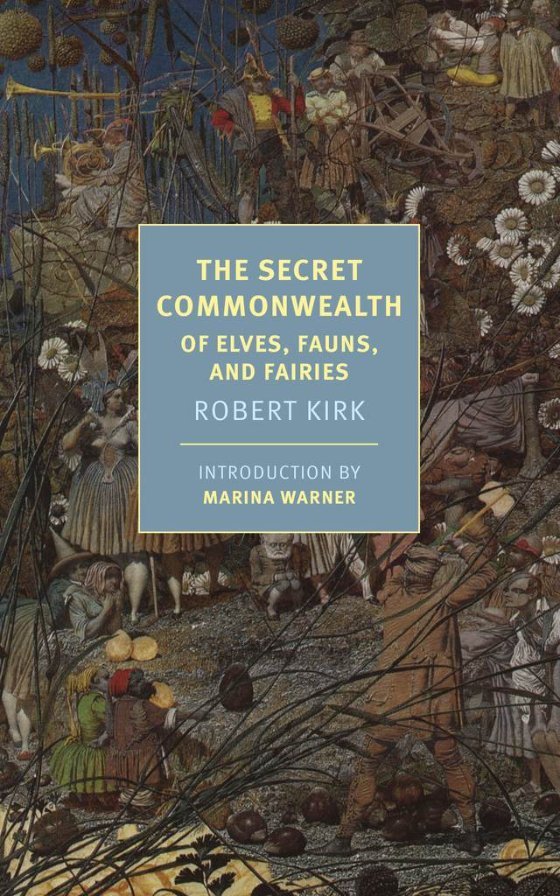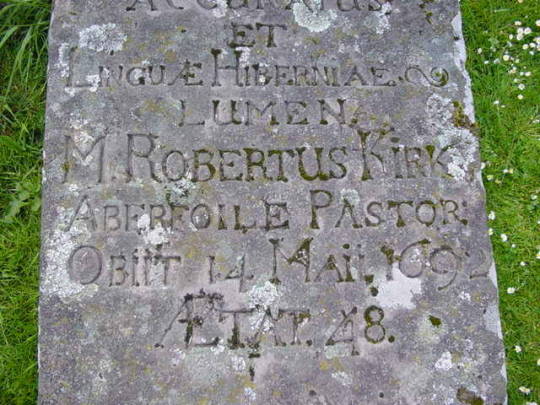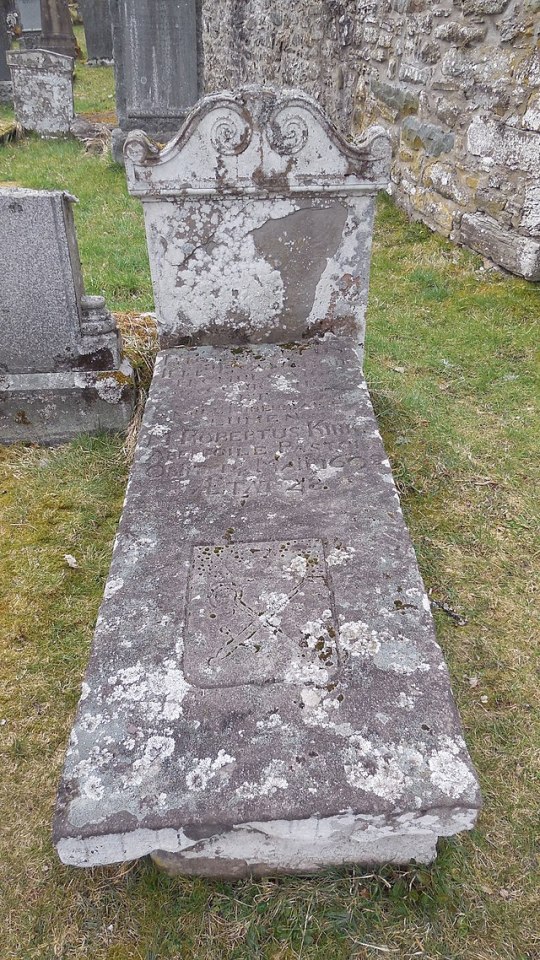#and the Reverend Robert Kirk ('the Secret Commonwealth of Elves Fauns and Fairies')
Text


Reverend Robert Kirk was born on December 9th 1644 at Aberfoyle.
Kirk was the seventh and youngest son of James Kirk, minister at Aberfoyle, Perthshire. He studied theology at St Andrews and received his master's degree at Edinburgh in 1661. He became minister of Balquhidder in 1664, and later of Aberfoyle, from 1685 until his death in 14 May 1692.
Robert Kirk is best known for his book “The Secret Commonwealth of Elves, Fauns, and Fairies” in 1691. In his book Kirk tells stories about folk who had contact to fairies including himself. Kirk also believed that the local Doon Hill was the gateway to the world of the fairies, also described as “The Secret Commonwealth“. Kirk is also known as the first person to translated the bible into Gaelic.
Reverend Kirk was a former resident of the Old Manse which is situated nearby the Fairy Knowe. The same house is known for the place where Sir Walter Scott wrote his famous poem “The Lady of the Lake“.
Not much off a story as such, but it was what happened after his death that is the bones of this post.
Having collapsed on Doon Hill during the night he was carted home and died of a suspected heart attack, but It is said that Reverend Kirk actually didn’t die on the hill but was carried away by the fairies. Thereafter Reverend Kirk appeared as a vision in front of his cousin Graham. He told him that he was not dead and that he would appear at the christening of Graham’s child. For Reverend Kirk it would be the only way to come back to life. When he appeared at the christening, Graham was to throw an iron dagger over Kirk. This would release him from captivity. Graham was too scared though and couldn’t do it. Now it is believed that Reverend Kirk’s soul is still inside the lone Scots Pine tree on Doon Hill.
His walks to Doon hill started usually from the church or The Manse. Doon hill is also known as “Fairy Knowe” or “Dun Sithean”. Locally the fairies have the name “Sithe”. The fairy walk leads to the conical hill which is situated in a relatively flat landscape by Aberfoyle.
Second two pics are his his grave at Aberfoyle
Much more about the Rev here https://www.thebottleimp.org.uk/.../the-supernatural.../
35 notes
·
View notes
Text
-Secret Lives of Elves and Faeries: The True Story of Rev Robert Kirk
Riley Winters
Faery at sunset
Born in 1644 in Aberfoyle, a parish of Perthshire, Scotland, Reverend Robert Kirk is remembered for apparently making great strides in bridging the gap between the human and faery realms.
He was the seventh son of his parents James and Mary, and went on to become a very intelligent, studious man. Attending the University of St. Andrews and the University of Edinburgh for his Bachelor's and Master's degrees respectively, Kirk chose to follow in his father's footsteps by becoming an Episcopal minister in Scotland.
In the Christian world, he is known for having completed and published one of the first translations of the Bible into Gaelic. But aside from his work in the realm of humans, Kirk had spent much of his life enamored and immersed in the tales of faeries. This fascination is what propels Kirk's name to the forefront of folkloric research.
Who was Reverend Robert Kirk?
What Reverend Robert Kirk is most known for, though his Biblical works were pertinent in his time, is the legacy of the faery race that he left behind. His ‘ The Secret Commonwealth of Elves, Fauns, and Faeries’ is thought today to be one of the best contributions to modern scholarship on the faery realm . What is most intriguing about this text, however, is that it was initially believed to have been an amalgamation of legends and myths the reverend collected during his life, condensed into a single work. Yet in more recent years, there is a belief that the earlier editions of Kirk's manuscript are actually much more personal.
Ten Discoveries of 2014 that Suggest there is Truth to Ancient Myths and Legends
The meaning of the word Myth
Bardsey Island - Haunting Island of Spiritual, Natural, and Cultural Significance
Somewhat paradoxically, Robert Kirk was both a Minister and a firm believer in the realm of faeries. ‘The Quarrel of Oberon and Titania’ by Noel Paton
Somewhat paradoxically, Robert Kirk was both a Minister and a firm believer in the realm of faeries. ‘The Quarrel of Oberon and Titania’ by Noel Paton. ( Public Domain )
Writing from Experience?
One scholar in particular, John Matthews, claims to have found an early copy of the reverend's manuscript, which bizarrely claims that Robert Kirk did more than collect Scottish tales - he lived them. This earlier edition, called ‘ The Secret Lives of Elves and Faeries,’ is caveated in its title as having come directly from the "private journal of the Reverend Robert Kirk."
It reads like a journal as well, and dictates Kirk's supposed journey from Aberfoyle to the "Lands Beneath," the faery realm below the earth, and the interesting discoveries he found there. Kirk describes in great detail the Seelie and Unseelie Courts (the good and bad faeries), faery food, and faery dress, their "books of light", and numerous faery tales told to him supposedly by the faeru folk themselves.
A Trial in the Fairy Realm
Though he reports being warmly welcomed into the kingdom of the Seelie Court and treated well there, Reverend Kirk's journal further dictates that, while below ground, he broke the rules of the Unseelie Court. Kirk ventured into the domain of the Unseelie, something forbidden to the race of mortal men. Kirk had known this as he had trespassed - and knowing the rule he was breaking made his circumstances all the worse.
Reverend Kirk claimed to have visited a secret realm of faeries. ‘Fairies looking through a passage’, by John Anster Fitzgerald, 19th century.
Reverend Kirk claimed to have visited a secret realm of faeries. ‘Fairies looking through a passage’, by John Anster Fitzgerald, 19th century. ( Public Domain )
This venture supposedly resulted in Kirk's trial at the hands of the Unseelie and Seelie alike—as one could not decide a ruling without the agreement of the other—during which Kirk's declaration that he would gladly forfeit his life to protect their secrets softened the court to him and offered him a choice between two punishments: to either die for his crimes, or to leave the world of his people and live the rest of his days in the faery realm. Kirk, so intrigued by all he had seen, chose the latter of the two "punishments", and only requested a brief return to the world above to get his affairs in order. This, many believe, is the true reason behind Kirk's mysterious death in 1692.
Just outside Aberfoyle is a strange conical hill known as the Fairy Knowe. According to legends, Reverend Kirk’s soul is believed to still be kept captive in the Fairy Queen's Palace underneath the Knowe
Just outside Aberfoyle is a strange conical hill known as the Fairy Knowe. According to legends, Reverend Kirk’s soul is believed to still be kept captive in the Fairy Queen's Palace underneath the Knowe. ( Public Domain )
Kirk’s Mysterious Death and His Legacy
It is said that Kirk greatly enjoyed taking walks in the evening, both in his childhood and his adult life, visiting the faery mounds of Aberfoyle that he had taken great pleasure in exploring all his life. His body was found in the morning on the faery hill, and legend spread throughout the region that Kirk had not truly died but had instead gone to live among the faeries as the chaplain to the faery queen .
Kirk never actually published his faery writings for himself. Rather they were discovered posthumously and published by Walter Scott in 1815—not as a journal, but as a text of legends of the faery race . Yet without his journal, Kirk quickly became regarded as having expert knowledge of the ‘Lands Beneath.’
Homunculus: The Alchemical Creation of Little People with Great Powers
Beware the Wandering Wilas
Elfdalian, the Ancient Viking Forest Language of Sweden, Set to be Revived
Panorama of famous mystic Fairy Glen at sunset, a green valley with romantic landscapes. ( valeryegorov /Adobe Stock)
John Matthews, in his research, recovered a letter to Kirk's son Colin dictating that Kirk had chosen to live the rest of his life in the court of the Seelie. However for many long years after his death, Kirk himself had become a faery legend . In many ways, he still remains a legend, as only so much can be believed from the supposed journal of a man fascinated by the races of the underground.
Whether he truly ventured to the ‘Lands Beneath’ or had a magnificent imagination for that which he was most passionate about, Kirk remains the epitome of faery realm knowledge.
0 notes
Text
Imagine being Robert Kirk writing his great exposé “The Secret Commonwealth” in the seventeenth century, like a whole early modern Presbyterian minister in kirk-fearing Scotland, known for translating the psalms into Gaelic, sitting there scribbling down whatever the latest hot goss about the Good Neighbours was until they had to put out a hit on you, what a life
#The Secret Commonwealth of Elves Fauns and Fairies#The Good Neighbours#Scottish folklore#Reverend Robert Kirk#Aberfoyle shenanigans much- I wasn't particularly moved by the clootie tree but the hill itself does have a weird feel#You can see why folk gave it the story
11 notes
·
View notes
Note
Hello there! I was recently approached and directed to begin work with the Witch Father. After doing some research on the various aspects of him, have identified him as The Faerie King. While I've lightly researched the fae/goodfolk before and had some interactions with them, I'm fairly new to working in their domain. Do you have any suggested resources to look into or advice before meeting him? Thank you! Your blog has been super helpful!
I’m sorry if my answer to this has come too late. I have had a lot on my plate. I will answer as best I can, though, all the same.
As far as resources go, some of the very best will simply cover things like local ecology, regional lore, and folk wisdom. However, here are some texts covering the topic of the Gloaming Folk that I can manage to think of at the moment:
‘The Secret Commonwealth of Elves, Fauns and Fairies’ by Reverend Robert Kirk
‘British Goblins’ by Wirt Sikes
‘The Encyclopedia of Fairies’ by Katherine Briggs
‘An Encyclopedia of Fairies: Hobgoblins, Brownies, Bogies, & Other Supernatural Creatures’ by Katherine Briggs
‘Fairy and Folktales of the Irish Peasantry’ by W. B. Yeats
‘The Fairy Faith in Celtic Countries’ by W. Y. Evans-Wentz
‘Sounds of Infinity’ by Lee Morgan
‘Elves, Wights and Trolls’ by Kveldulfr Gundarson
‘The Fairy Mythology: Illustrative of the Romance and Superstition of Various Countries’ by Thomas Keightley
‘The Gaelic Otherworld’ by John Campbell
‘The Fairies in Tradition and Literature’ by Katherine Briggs
‘The Vanishing People: Fairy Lore and Legends’ by Katherine Briggs
‘The Fairy Family: A Series of Ballads & Metrical Tales Illustrating the Fairy Mythology of Europe’ by A. Maclaren
Based on the larger context of your question, regarding the Witch Father, it may also be worthwhile to look into some texts such as:
‘Call of the Horned Piper’ by Nigel Aldcroft Jackson
‘The Devils Dozen: Thirteen Craft Rites of the Old One’ by Gemma Gary
or the ‘Witchcraft in the British Isles’ series by Michael Howard
As far as advice goes;
Be sure, be ready, and be heedful.
130 notes
·
View notes
Photo



Reverend Robert Kirk was born on December 9th 1644 at Aberfoyle.
Kirk was the seventh and youngest son of James Kirk, minister at Aberfoyle, Perthshire. He studied theology at St Andrews and received his master's degree at Edinburgh in 1661. He became minister of Balquhidder in 1664, and later of Aberfoyle, from 1685 until his death in 14 May 1692.
Robert Kirk is best known for his book “The Secret Commonwealth of Elves, Fauns, and Fairies” in 1691. In his book Kirk tells stories about folk who had contact to fairies including himself. Kirk also believed that the local Doon Hill was the gateway to the world of the fairies, also described as “The Secret Commonwealth“. Kirk is also known as the first person to translated the bible into Gaelic.
Reverend Kirk was a former resident of the Old Manse which is situated nearby the Fairy Knowe. The same house is known for the place where Sir Walter Scott wrote his famous poem “The Lady of the Lake“.
Not much off a story as such, but it was what happened after his death that is the bones of this post.
Having collapsed on Doon Hill during the night he was carted home and died of a suspected heart attack, but It is said that Reverend Kirk actually didn’t die on the hill but was carried away by the fairies. Thereafter Reverend Kirk appeared as a vision in front of his cousin Graham. He told him that he was not dead and that he would appear at the christening of Graham’s child. For Reverend Kirk it would be the only way to come back to life. When he appeared at the christening, Graham was to throw an iron dagger over Kirk. This would release him from captivity. Graham was too scared though and couldn’t do it. Now it is believed that Reverend Kirk’s soul is still inside the lone Scots Pine tree on Doon Hill.
His walks to Doon hill started usually from the church or The Manse. Doon hill is also known as “Fairy Knowe” or “Dun Sithean”. Locally the fairies have the name “Sithe”. The fairy walk leads to the conical hill which is situated in a relatively flat landscape by Aberfoyle.
Second two pics are his his grave at Aberfoyle
Much more about the Rev here https://www.thebottleimp.org.uk/2016/12/the-supernatural-worlds-of-robert-kirk-fairies-beasts-landscapes-and-lychnobious-liminalities/
32 notes
·
View notes